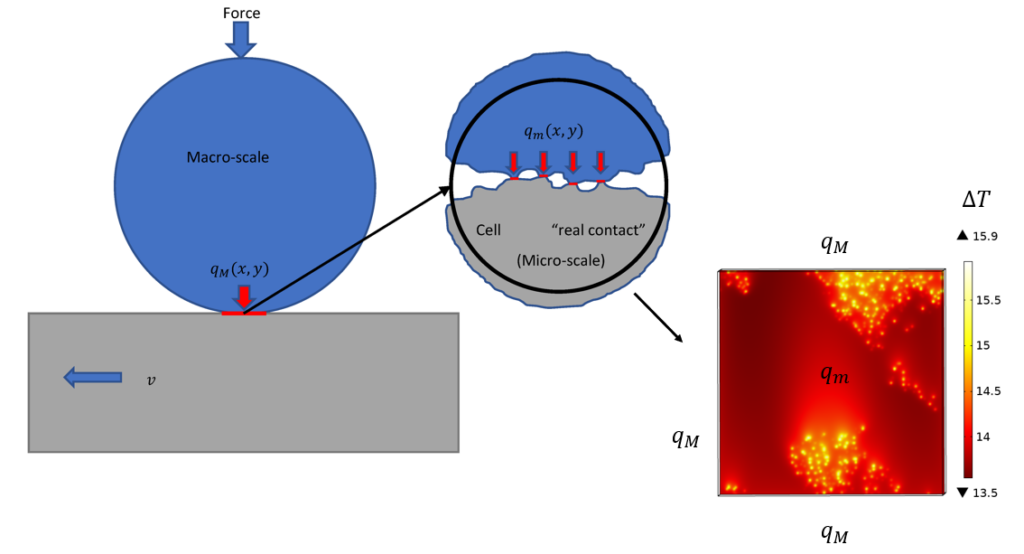PhD Student at the Luleå University of Technology (LTU), Machine Elements, Department of Engineering Sciences and Mathematics.
Unlocking the Secrets of Sliding Systems: A Multi-Scale Flash Temperature Model
Dear Readers,
In the captivating world of mechanical engineering, where surfaces slide and interact, an important discovery promises to improve our understanding of friction, wear, and heat generation. Researchers have unveiled an innovative multi-scale flash temperature model that not only sheds light on the elusive phenomenon of flash temperatures but also opens a plethora of possibilities for diverse industries. Today, I am thrilled to present to you the groundbreaking insights and potential industry applications of this extraordinary method.
Friction is an inevitable force that arises when two surfaces interact, leading to the conversion of mechanical energy into heat. In the quest to comprehend this intricate process, scientists have long been intrigued by the enigmatic flash temperatures that occur at the microscopic level of contact between asperities. Until now, accurately predicting these flash temperatures remained a challenging puzzle, limited by conventional models that often lack precision and adaptability.

Figure 1. Macro region pin-on-disc.
The multi-scale flash temperature model emerges as a game-changer in the world of tribology. Developed and rigorously validated against existing research, this unique model possesses a core strength – its adaptability to predict flash contact temperatures across various types of sliding systems. The novelty lies in its ability to bridge the gap between macro and micro scales, offering a comprehensive understanding of temperature development at both levels.
The development of this model is founded on a series of innovative multi-scale steps, designed to overcome computational challenges, and achieve unparalleled accuracy.
- The model begins by defining the macro-scale problem, encompassing any type of contact between bodies. This could involve surfaces of varying sizes, shapes, and kinematic conditions. Importantly, surface roughness is not initially included in this stage.
- Instead of attempting to simulate the entire contact domain with countless micro-scale asperities, researchers identify a small region within the contact known as the “cell.” This region is strategically selected as it represents the micro-scale contact model.
- Surface roughness plays a pivotal role in mechanical contacts, affecting friction, wear, and heat generation. In this step, the researchers precisely define surface irregularities within the cell, utilizing specific roughness parameters to represent the intricate details of the asperities.
- Armed with the surface roughness information, the local contact mechanic problem over the cell area is solved, providing the foundation for thermal modelling.
- The multi-scale flash temperature model employs a coupling approach to bridge the thermal behaviour between the macro and micro scales. The contact pressure distribution obtained from the previous step acts as input to the cell of the thermal model.
- By focusing on a small region and accounting for surface roughness, the model achieves remarkable efficiency while retaining accuracy. This strategic approach saves valuable computational time, allowing for simulations with unprecedented speed and precision.
The significance of the multi-scale flash temperature model extends far beyond the realm of academic research. Its potential applications hold promise for various industries, empowering engineers to optimize designs, improve performance, and drive innovation.

Figure 2. Micro region cell.
In the automotive sector, the coupling method stands to improve brake system design. Engineers envision leveraging its predictive power to optimize brake performance across diverse driving conditions.
Manufacturing industries eagerly anticipate using the method to simulate temperature evolution during complex thermo-mechanical events. By understanding the heat generation during machining and forming processes, manufacturers can optimize production parameters, reduce energy consumption, and elevate product quality.
In the aerospace industry, the method holds the potential to unlock a new era of high-performance components. From turbine blades to critical engine parts, engineers envision using the method to design components capable of withstanding extreme thermal stresses, ensuring safety and reliability in the skies.
Beyond traditional engineering fields, the multi-scale flash temperature model finds applications in biomedical research. It offers the potential to deepen the understanding of friction and heat generation in medical devices and implants, driving advancements in biocompatible materials and enhancing patient outcomes.
As we explore the achievements of the multi-scale flash temperature model, it becomes clear that the journey is ongoing. Researchers and engineers remain dedicated to fine-tuning the method, expanding its scope and applications.
In conclusion, the multi-scale flash temperature model stands as a beacon of innovation in the world of tribology. Its adaptability, precision, and potential to revolutionize various industries make it a compelling prospect for the future of friction studies. As we embrace this exciting advancement, let us anticipate a future where the mysteries of friction are unlocked, and the power of multi-scale coupling propels us into a new era of engineering excellence.
References
https://link.springer.com/article/10.1007/s11249-021-01504-z



Be the first to comment